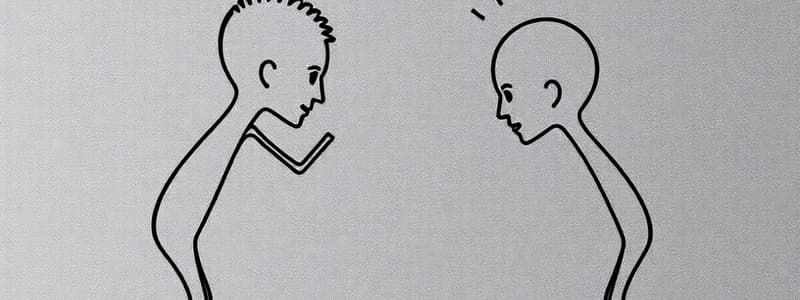Podcast
Questions and Answers
What does the Law of Effect state?
What does the Law of Effect state?
- Behaviors are influenced solely by biological factors.
- Behaviors with favorable consequences will occur less frequently.
- Behaviors with favorable consequences will occur more frequently. (correct)
- Behaviors with unfavorable consequences will occur more frequently.
Which type of reinforcement involves increasing the likelihood of a behavior by presenting a favorable outcome?
Which type of reinforcement involves increasing the likelihood of a behavior by presenting a favorable outcome?
- Secondary Reinforcement
- Positive Reinforcement (correct)
- Punishment
- Negative Reinforcement
What is positive punishment?
What is positive punishment?
- Adding an undesirable stimulus after a behavior (correct)
- Removing a desirable stimulus after a behavior
- Recognizing a behavior with praise
- Encouraging a behavior through rewards
Which of the following is a potential downside of punishment?
Which of the following is a potential downside of punishment?
What is an example of negative reinforcement?
What is an example of negative reinforcement?
Which of the following scenarios reflects operant conditioning?
Which of the following scenarios reflects operant conditioning?
In the context of operant conditioning, what does shaping refer to?
In the context of operant conditioning, what does shaping refer to?
What is the main difference between primary and secondary reinforcement?
What is the main difference between primary and secondary reinforcement?
What is continuous reinforcement primarily useful for?
What is continuous reinforcement primarily useful for?
Which schedule of reinforcement provides rewards after an unpredictable time period?
Which schedule of reinforcement provides rewards after an unpredictable time period?
How does immediate reinforcement compare to delayed reinforcement in terms of effectiveness?
How does immediate reinforcement compare to delayed reinforcement in terms of effectiveness?
Which of the following statements about punishment is correct?
Which of the following statements about punishment is correct?
What is a key component of developing a new habit according to operant conditioning principles?
What is a key component of developing a new habit according to operant conditioning principles?
Which of the following types of reinforcement schedules rewards only some correct responses?
Which of the following types of reinforcement schedules rewards only some correct responses?
In operant conditioning, what is an essential characteristic of reinforcement?
In operant conditioning, what is an essential characteristic of reinforcement?
Which of the following can be considered a form of punishment?
Which of the following can be considered a form of punishment?
How does negative punishment work?
How does negative punishment work?
What can aggressive behavior modeled by adults lead to in children?
What can aggressive behavior modeled by adults lead to in children?
What type of learning is represented by operant conditioning?
What type of learning is represented by operant conditioning?
What is a potential issue with continuous reinforcement?
What is a potential issue with continuous reinforcement?
Flashcards
Operant Conditioning
Operant Conditioning
The process of learning where the frequency of a behavior depends on the consequences that follow it.
The Law of Effect
The Law of Effect
Behaviors with favorable consequences are repeated more often, while those with unfavorable consequences become less frequent.
Reinforcement
Reinforcement
Any consequence that increases the likelihood of a behavior.
Punishment
Punishment
Signup and view all the flashcards
Positive Reinforcement
Positive Reinforcement
Signup and view all the flashcards
Negative Reinforcement
Negative Reinforcement
Signup and view all the flashcards
Immediate Reinforcement
Immediate Reinforcement
Signup and view all the flashcards
Primary Reinforcement
Primary Reinforcement
Signup and view all the flashcards
Secondary Reinforcement
Secondary Reinforcement
Signup and view all the flashcards
Positive Punishment
Positive Punishment
Signup and view all the flashcards
Negative Punishment
Negative Punishment
Signup and view all the flashcards
Shaping
Shaping
Signup and view all the flashcards
Continuous Reinforcement
Continuous Reinforcement
Signup and view all the flashcards
Partial Reinforcement
Partial Reinforcement
Signup and view all the flashcards
Fixed Interval Schedule
Fixed Interval Schedule
Signup and view all the flashcards
Variable Interval Schedule
Variable Interval Schedule
Signup and view all the flashcards
Fixed Ratio Schedule
Fixed Ratio Schedule
Signup and view all the flashcards
Variable Ratio Schedule
Variable Ratio Schedule
Signup and view all the flashcards
Study Notes
Operant Conditioning
- Operant conditioning is a type of learning where the frequency of a behavior depends on the consequences that follow.
- Consequences that increase the likelihood of a behavior are called reinforcement, while those that decrease the likelihood are called punishment.
- Edward Thorndike developed the law of effect, suggesting behaviors with positive consequences occur more frequently, and those with negative consequences occur less frequently.
- B.F. Skinner furthered the principles of operant conditioning.
- Reinforcement can be positive (adding something desirable) or negative (removing something undesirable).
- Punishment can be positive (adding something undesirable) or negative (removing something desirable).
The Law of Effect
- Behaviors with favorable consequences become more frequent.
- Behaviors followed by unfavorable consequences become less frequent.
- This principle was developed by Edward Thorndike.
Reinforcement and Punishment
- Reinforcement increases the likelihood of a behavior.
- Punishment decreases the likelihood of a behavior.
- Positive reinforcement adds something desirable.
- Negative reinforcement removes something undesirable.
- Positive punishment adds something undesirable.
- Negative punishment removes something desirable.
Skinner Box
- A Skinner box is a device used to study operant conditioning.
- It is a small enclosure with a lever or button that an animal can press to receive a reward (e.g., food) or avoid a punishment (e.g., shock).
- This allows researchers to observe how consequences shape behavior.
Positive and Negative Reinforcement
- Positive reinforcement: adding a desirable stimulus to increase behavior. (e.g., praising a child for good behavior)
- Negative reinforcement: removing an undesirable stimulus to increase behavior. (e.g., taking aspirin to relieve a headache)
Immediate vs. Delayed Reinforcement
- Immediate reinforcement is more effective than delayed reinforcement.
- The immediate reward, like nicotine, outweighs long-term health consequences.
- Delaying gratification is a crucial skill for long-term success.
Primary vs. Secondary Reinforcement
- Primary reinforcement: naturally rewarding stimuli (e.g., food, water).
- Secondary reinforcement: learned rewarding stimuli (e.g., money, praise).
Schedules of Reinforcement
- Continuous reinforcement: rewarding every correct response. (e.g., a child gets a cookie every time they clean their room)
- Partial reinforcement: rewarding some correct responses.
- Fixed interval: reward after a fixed time interval. (e.g., a quiz every Friday)
- Variable interval: reward after a variable time interval. (e.g., pop quizzes)
- Fixed ratio: reward after a fixed number of correct responses. (e.g., buy 10 coffees get 1 free)
- Variable ratio: reward after a variable number of correct responses.(e.g., slot machines)
Interval Schedules
- Fixed interval: reward after a fixed time period. (e.g., bi-weekly paychecks)
- Variable interval: reward after varying time periods. (e.g., pop quizzes)
Ratio Schedules
- Fixed ratio: reward after a set number of responses. (e.g., piece-rate pay)
- Variable ratio: reward after a varying number of responses. (e.g., gambling)
The Role of Cognition
- Latent learning: learning that occurs but isn't immediately evident.
- Overjustification effect: rewarding a behavior already enjoyed, potentially reducing intrinsic motivation.
Learning New Habits
- Self-control is key to learning new habits.
- Exercising self-control in one area can improve it in other areas.
Common Problems with Punishment
- Punishment doesn't eliminate the desire for the behavior.
- It can lead to fear, anxiety, and aggression.
Shaping
- Shaping. Reinforcing behaviors that are increasingly similar to the desired behavior.
Studying That Suits You
Use AI to generate personalized quizzes and flashcards to suit your learning preferences.




